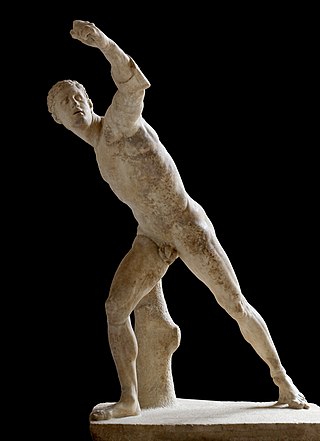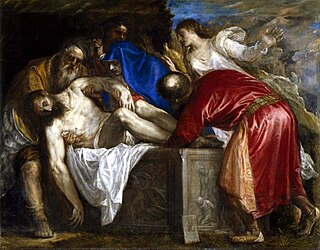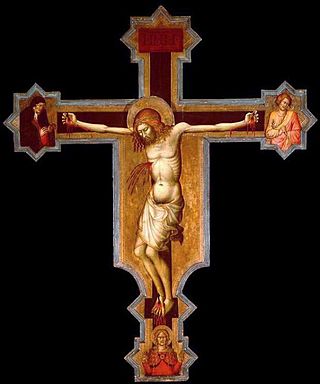
Antonio Allegri da Correggio, usually known as just Correggio, was the foremost painter of the Parma school of the High Italian Renaissance, who was responsible for some of the most vigorous and sensuous works of the sixteenth century. In his use of dynamic composition, illusionistic perspective and dramatic foreshortening, Correggio prefigured the Baroque art of the seventeenth century and the Rococo art of the eighteenth century. He is considered a master of chiaroscuro.

Luca Giordano was an Italian late-Baroque painter and printmaker in etching. Fluent and decorative, he worked successfully in Naples, Rome, Florence, and Venice, before spending a decade in Spain.

The Virgin of the Rocks, sometimes the Madonna of the Rocks, is the name of two paintings by the Italian Renaissance artist Leonardo da Vinci, of the same subject, with a composition which is identical except for several significant details. The version generally considered the prime version, the earlier of the two, is unrestored and hangs in the Louvre in Paris. The other, which was restored between 2008 and 2010, hangs in the National Gallery, London. The works are often known as the Louvre Virgin of the Rocks and London Virgin of the Rocks respectively. The paintings are both nearly 2 metres high and are painted in oils. Both were originally painted on wooden panels, but the Louvre version has been transferred to canvas.

The Gallerie dell'Accademia is a museum gallery of pre-19th-century art in Venice, northern Italy. It is housed in the Scuola della Carità on the south bank of the Grand Canal, within the sestiere of Dorsoduro. It was originally the gallery of the Accademia di Belle Arti di Venezia, the art academy of Venice, from which it became independent in 1879, and for which the Ponte dell'Accademia and the Accademia boat landing station for the vaporetto water bus are named. The two institutions remained in the same building until 2004, when the art school moved to the Ospedale degli Incurabili.

Claudio Coello was a Spanish Baroque painter. Coello is considered the last great Spanish painter of the 17th century.

The Borghese Gladiator is a Hellenistic life-size marble sculpture portraying a swordsman, created at Ephesus about 100 BC, now on display at the Louvre.

Bartolo di Fredi, also called Bartolo Battiloro, was an Italian painter, born in Siena, classified as a member of the Sienese School.

Francesco de Mura was an Italian painter of the late-Baroque period, active mainly in Naples and Turin. His late work reflects the style of neoclassicism.

Santa Maria Maddalena dei Pazzi is a Renaissance-style Roman Catholic church and a former convent located in Borgo Pinti in central Florence, Italy.

The Life of the Virgin, showing narrative scenes from the life of Mary, the mother of Jesus, is a common subject for pictorial cycles in Christian art, often complementing, or forming part of, a cycle on the Life of Christ. In both cases the number of scenes shown varies greatly with the space available. Works may be in any medium: frescoed church walls and series of old master prints have many of the fullest cycles, but panel painting, stained glass, illuminated manuscripts, tapestries, stone sculptures and ivory carvings have many examples.

The Madonna with the Blue Diadem is a painting by Raphael and his pupil Gianfrancesco Penni, and was most likely painted in Rome around 1510-1512, now at the Louvre. In the Louvre, the painting is named Virgin and Child with the Infant Saint John, also known as Virgin with the Veil or Virgin with the Blue Diadem. Additional names include Virgin with the Linen, Slumbering Child and Silence of the Holy Virgin.

The Entombment is a 1559 oil-on-canvas painting by the Venetian painter Titian, commissioned by Philip II of Spain. It depicts the burial of Jesus in a stone sarcophagus, which is decorated with depictions of Cain and Abel and the binding of Isaac. The painting measures 137 cm × 175 cm and is now in the Museo del Prado in Madrid. Titian made several other paintings depicting the same subject, including a similar version of 1572 given as a gift to Antonio Pérez and now also in the Prado, and an earlier version of c.1520 made for the Duke of Mantua and now in the Louvre.

The Adoration of the Shepherds by the Le Nain Brothers is in the National Gallery in London. The painting dates from about 1640, and is relatively unusual as a religious subject or history painting in their oeuvre; they are best known for genre painting, especially groups of peasants. As with most of the works of Antoine, Louis and Mathieu (1607–1677) Le Nain, it is not possible to establish which brother, or combination of brothers, painted it. This painting is unsigned, but when they signed their works, from 1641 to 1648, it was simply as Lenain.

The Museum & Gallery, Inc. is currently located on the campus of Bob Jones University in Greenville, South Carolina. It was established in 1951, and focuses on sacred art, mainly European Old Master paintings, but also includes smaller collections of sculpture, furniture, architectural elements, textiles, Greek and Russian icons, and ancient artifacts. As of 2017, the museum is closed for a planned move to downtown Greenville, SC.

Saint Luke Painting the Virgin is a 1650-1655 oil painting by the Italian Baroque artist Luca Giordano, now in the Musée des Beaux-Arts de Lyon. It shows Saint Luke painting the Virgin. Another work by Giordano on the same subject is now in the Museo de Arte in Ponce, Puerto Rico.

Adoration of the Shepherds is a painting by the Italian late Baroque artist Luca Giordano, executed c. 1688, and commissioned for the queen's apartments in the Palacio Real in Madrid, or perhaps at the Royal Palace of Aranjuez, near Madrid. It was produced at the same time as the same artist's Marriage of the Virgin, as part of a set of paintings of the Life of the Virgin intended for the queen's bedroom. Both works are now in the Louvre in Paris.

The Adoration of the Shepherds is a 1644 oil-on-canvas painting by the French artist Georges de La Tour. It is now in the Louvre Museum, in Paris, which purchased it in 1926.

Adoration of the Magi is a painting in tempera on wood panel by Luca Signorelli (1450–1523) and his assistants, executed c. 1493–1494, and now in the Louvre in Paris. It was probably the first painting he produced in Città di Castello, and originally hung over the main altar of the monastery church of Sant'Agostino. The surface displayed within the frame is 331 cm by 245.5 cm. In late 2022 it was not on display.


















